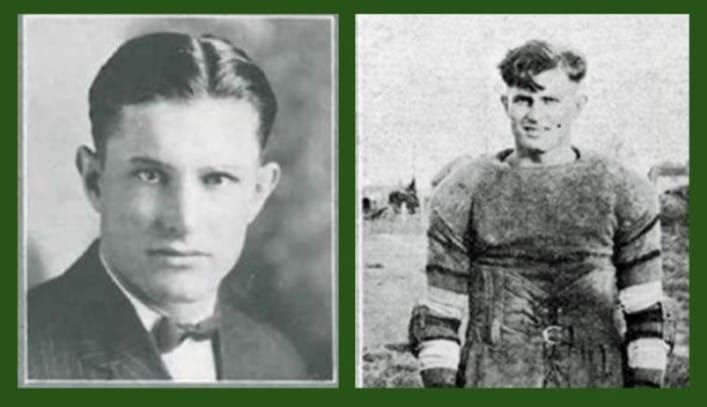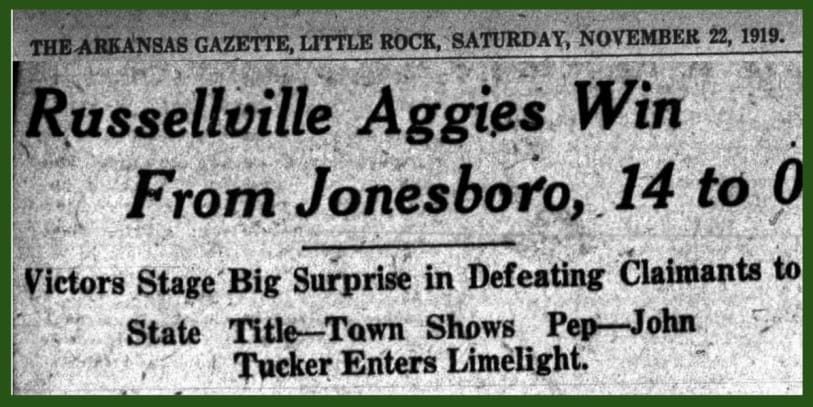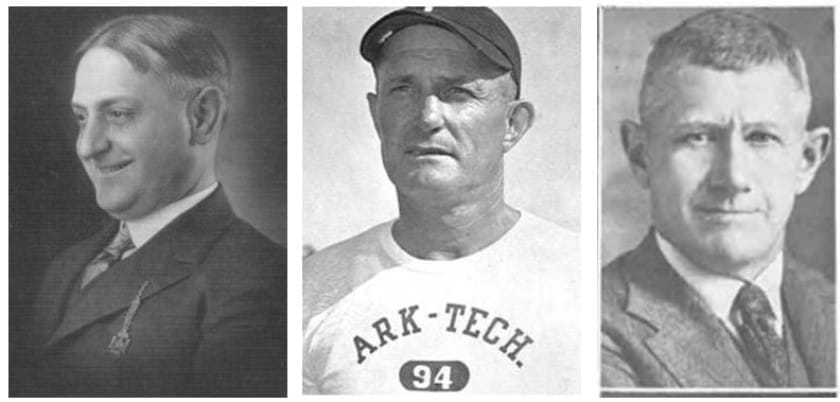

Uh oh...
It appears that you're using a severely outdated version of Safari on Windows. Many features won't work correctly, and functionality can't be guaranteed. Please try viewing this website in Edge, Mozilla, Chrome, or another modern browser. Sorry for any inconvenience this may have caused!
Read More about this safari issue.

A president, a coach, and a quarterback change Arkansas Tech history forever.
On November 6, 1923, a chartered train called the Wonder Boy Special left the Russellville, Arkansas, station bound for the United States Military Academy at West Point, New York. The Wonder Boys from the agricultural school on the north side of town had a historic football date with Army on Saturday, November 10. Arkansas Tech historian Dr. Thomas DeBlack described a departing aggregation that one local dignitary called a “county fair on wheels.”
The train was made up of five Pullman sleeping cars and one baggage car which had been converted into an exhibition booth filled with products from the Agricultural School farm and garden and handiwork of the students in the shops, carpentry, domestic science, and domestic art departments.
A local businessman had been elected as the “official cheerleader and spokesman for the fans,” but anyone assuming or presuming authority in any capacity at this time will doubtless relinquish his prerogatives when Hugh Critz boards the train in St. Louis tomorrow morning.
That ambitious road trip to West Point was the culmination of an amazing rise to football prominence by a bucolic educational institution called the Second District Agricultural School. It was an important time in the history of the college that would become Arkansas Tech University, but for that assentation to football excellence to take place it would take the providential arrival of three exceptional leaders.
1918

The three men destined to successfully lead Second District Agricultural School arrived at what might be considered the most critical period in the institution’s history. A diminished student population due to World War I and a worldwide pandemic had reduced student enrollment to just over 100. Fluctuating farm prices threatened family farms and jeopardized the very mission the school was designed to address. Only six diplomas were awarded in the spring of 1918, and the interim president had resigned after six months of laboring with seemingly insurmountable problems.
Despite the ominous situation, the struggling institution had attracted a promising applicant for its fifth president. Hugh Melville Critz was a successful farmer, a qualified academic leader, and an accomplished communicator. The 41-year-old native of Starkville, Mississippi, had earned a BS in agriculture from Mississippi A&M (Mississippi State) in 1896 and had subsequently held several positions at various postsecondary schools in Mississippi, Alabama, and Tennessee. Not only was he qualified by experience, but he also welcomed a challenge at a school on the brink of disaster.
The new president moved to Russellville in the summer of 1918. The Critz family included his wife Julia, a daughter Julia Moon, a son Wiley, and 17-year-old Hugh Melville Critz Jr. The younger Hugh Critz, known locally as “Hughie,” would soon become a celebrity in his new hometown. By the early 1920s, “Hughie” Critz was on his way to becoming a major league baseball star.
In the 1918-1919 school year, Critz concentrated on improving Second District’s position in the farming community of the Arkansas River Valley. He opened the campus to farmers, 4H members, and summer agricultural camps. Perhaps more importantly, he built an infectious optimism in a community that was ready for some good news.
1919

In the fall of 1919, Critz had another idea to promote the school. He had been an accomplished athlete in his youth and starred on the Mississippi A&M baseball team in college. Hugh Critz knew how valuable sports could be in student morale and school spirit.
Although Second District had fielded a football team since the school opened in 1910, the Aggies had played only two games in the last three years. When school began in the fall of 1919, Second District announced a six-game football schedule that included Arkansas Normal (UCA), Jonesboro Agricultural (ASU), and Arkansas Cumberland (U of O).
While football on campus was not new, there was something special about football at Second District in the fall of 1919. The new addition was an 18-year-old quarterback from Russellville named John E. Tucker.
Tucker did not enroll until mid-October, missing a 63-0 loss to Arkansas Normal and a 0-0 tie with Van Buren High School. He first appears in game reports of a 12-7 loss to Hendrix on October 11 and a 73-0 win over Cumberland College (University of the Ozarks) on November 1. By the season’s final game, the Aggies had found a star, and the Arkansas Gazette had discovered a “wonder boy” that the paper would promote for the next four years.
The state paper sent a reporter to Russellville on November 21 for the big game between the teams identified by the paper as the Jonesboro Aggies, claimants to the state title, and the Russellville Aggies, featuring John Tucker. The Tucker-led Aggies prevailed 14-0. The Gazette report of the game was the first of many over the next four years promoting the exploits of a hometown hero named John Tucker.
To sum up his work this afternoon in a nutshell, John Tucker did everything but carry the water bucket.” — William A. Wilson Arkansas Gazette

1920
With things looking up at the agricultural school and football making headlines, Hugh Critz’s next move was to hire a nationally respected coach. Critz chose Edgar O. Brown, the coach at Central Missouri and a graduate of Wabash College in Indiana. Unlike the effusive president and the headline-generating star quarterback, Brown dodged the headlines and was a man of few words.

Although the new coach was known as “Silent Brown,” he was a skilled tactician and a respected leader of young men. Coach Brown moved the fledgling team to a new level. Arkansas Gazette sports editor Henry Loesch began to cover the games personally and promote a larger-than-life culture that identifies Arkansas Tech athletics today.
Brown’s first team went undefeated with 0-0 ties vs. Hendrix and the University of Arkansas Freshman team. The Aggies paid Arkansas Normal back for the previous year’s humiliating loss by shutting out the newly christened Bears 49-0 on their way to a 4-0-2 record.
Despite his position as an unbiased reporter, Arkansas Gazette editor Henry Loesch could not contain his respect for the Second District’s “wonder team.” At various times he called them the “wonder team of 1920,” “wonder team of the year,” and the “wonder team of Arkansas football.”
After the season’s final game wrapped up the Aggies undefeated campaign, Loesch capitalized the name “Wonder Boys” in his season-ending headline. The tradition established by that inspirational team and their remarkable quarterback has remained the superhero image of Arkansas Tech University for more than 100 years.

The Wonder Boys posted a 7-0 record in 1921, allowing only seven points in a seven-win season. The wins included a 67-0 drubbing of Arkansas Normal and shutout victories over six of their seven opponents.
In 1922, the Wonder Boys lost to the University of Tulsa 14-12, the only points the team allowed for the entire season. The Wonder Boys defeated Arkansas Normal 56-0, Jonesboro Agricultural 69-0, and Magnolia Agricultural 118-0 on their way to a 8-1 record.
In 1923, John Tucker suffered a broken collar bone in the game with Arkansas Normal on October 28. He missed a tie with Henderson and a 44-0 loss on the “Wonder Boys” trip to West Point, but he returned for two decisive victories that capped a 6-1-1 season.
John Tucker returned for his final season in 1924. Two ties and a lopsided loss to Texas A&M were the only blemishes on a 6-1-2 record. The 1925 yearbook included this tribute. “John has carved a niche for himself in the A. P. C. (Arkansas Polytechnic College) Hall of Fame that time will not erase.”
The Legacy of Critz, Brown and Tucker

Edgar Brown remained the Wonder Boys’ head coach until 1933 when he moved to the College of the Ozarks as coach and athletic director. His replacement at Arkansas Tech was John E. Tucker.
Hugh Critz took a leave of absence in the 1923-24 school year. His only presidential duty in 1923 was as the leader of the expedition to West Point. Critz remained in Mississippi for the remainder of his life.
John E. Tucker continued to coach and teach at his alma mater until the mid-1960s. He was inducted into the Arkansas Sports Hall of Fame in 1962.
After losing to Hendrix in John Tucker’s first game, the Wonder Boys did not lose to an Arkansas team for four consecutive seasons from 1919 to 1923.
Here Come the Wonder Boys is dedicated to the Hugh Critz family, whose interest in their great-grandfather’s story inspired this research.

The work of Dr. Tom DeBlack, ATU historian, and Sam Strasner, Arkansas Director of University Relations, were invaluable resources for this story.
We do the work.
You check your email.
Sign up for our weekly e-news.
Get stories sent straight to your inbox!







Like this story? Read more from Jim Yeager
The 1951 baseball season arrived in Little Rock with little cause for...
In 1994, Hall of Famer Ted Williams was contracted to create his personal...
America’s Greatest Generation returns from WWII to lead Arkansas Tech...
Join the Conversation
Leave a Comment